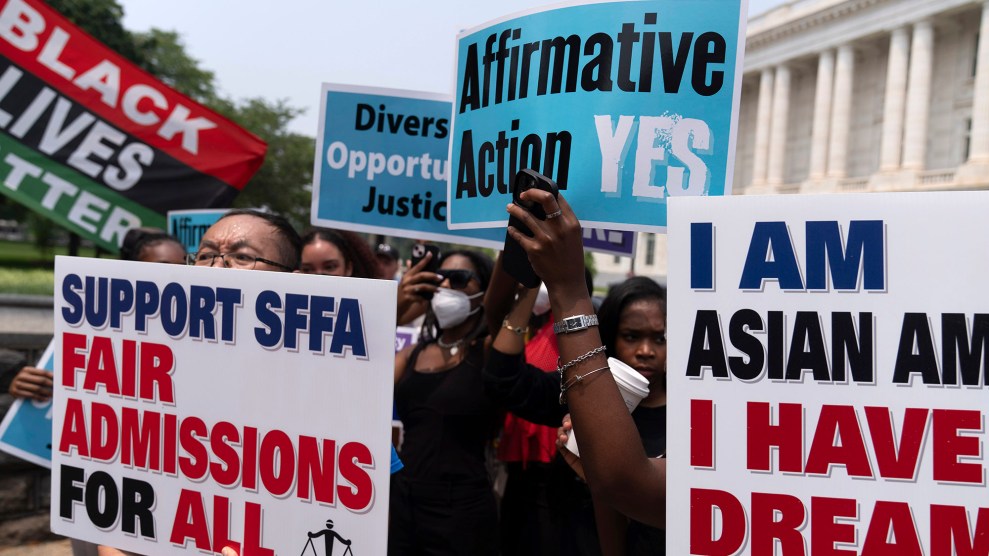Last Sunday, Jon Gertner had a good piece for the New York Times Magazine about the living wage campaigns that are proving extremely popular—and successful—in cities across the country. The main point of the piece is that the progressives running these campaigns tend to make their appeals in moral, rather than economic terms, and suggests that its popularity could even make it a liberal wedge issue; as one living-wage advocate says, “This is our gay marriage.”
But Gertner also takes time to point out that the economic case for raising the minimum wage can hold its own too. Here, for instance, is what happened in Santa Fe, which voted to raise the local minimum to $8.50 an hour in 2003. Granted, Gertner considers “data” a plural word (which is strictly correct but still ludicrous), but the rest is good:
To look at the data that have accumulated since the wage went into effect is to get a more positive impression of the law. Last month, the University of New Mexico’s Bureau of Business and Economic Research issued some preliminary findings on what had happened to the city over the past year and a half. The report listed some potential unintended consequences of the wage raise: the exemption in the living-wage law for businesses with fewer than 25 employees, for instance, created “perverse incentives” for owners to keep their payrolls below 25 workers. There was some concern that the high living wage might encourage more high-school students to drop out; in addition, some employers reported that workers had begun commuting in to Santa Fe to earn more for a job there than they could make outside the city.
Yet the city’s employment picture stayed healthy – overall employment increased in each quarter after the living wage went into effect and was especially strong for hotels and restaurants, which have the most low-wage jobs.
That jibes with what economists David Card and Alan Krueger found in their study on the minimum wage. Why wouldn’t a wage hike force employers to hire fewer workers? They reasoned that in the actual, existing labor market, employers might often have various undue advantages over their workers and as a result, businesses are able to bargain wages below what they would be in a market where wages were determined solely by supply and demand, in order to raise their profits. A minimum wage simply corrects this imbalance. Back to Gertner:
Most encouraging to supporters: the number of families in need of temporary assistance – a reasonably good indicator of the squeeze on the working poor – has declined significantly. On the other hand, the city’s gross receipts, a reflection of consumer spending and tourism, have been disappointing since the wage went into effect. That could suggest that prices are driving people away. Or it could merely mean that high gas and housing prices are hitting hard. The report calculates that the cost of living in Santa Fe rose by 9 percent a year over the past two and a half years.
Opponents of the minimum wage tend to argue that hiking the floor for wages will only increase inflation, as businesses are “forced” to increase prices, but they rarely cite any sort of proof, and it remains to be seen whether this is actually what happened in Santa Fe. It’s worth noting that last year, after Florida raised its state minimum, prices in local restaurants only rose about 3 percent. It’s also worth noting that workers will almost certainly come out ahead even factoring in for inflation—that was the case in Baltimore after living wage laws went into effect in 1994. (Granted, runaway inflation would definitely hurt workers, but as James K. Galbraith pointed out a while back, there’s no evidence that an inflationary spiral induced by a wage increase has ever occurred.) One more quote:
Rob Day of the Santa Fe Bar and Grill sees this [i.e., the high cost of living] as the crux of the matter. In his view, the problem with Santa Fe is the cost of housing, and there are better ways than wage regulations – housing subsidies, for example – to make homes more affordable. In the wake of the wage raise, Day told me, he eventually tweaked his prices, but not enough to offset the payroll increases. He let go of his executive chef and was himself working longer hours. “Now in the matter of a year and a half, I think there is a whole group of us who thought, If we were going to start over, this isn’t the business we would have gone into,” he says.
Some of Day’s concerns are valid, and it’s true, some individual businesses may suffer, but on the whole, it’s hard to be sympathetic here. Between 1968 and 2004, domestic corporate profits rose 85 percent while the minimum wage fell 41 percent and the average hourly wage fell 4 percent. In the retail sector, profits have gone up 159 percent. Obviously capitalism wouldn’t work very well if no one made a profit, but even a living wage is hardly going to put that in danger. (Moreover, some evidence, again, from Baltimore’s experiment with a living wage in the 1990s, suggested that some employers absorb the increase in labor costs through efficiency gains, especially lower turnover and “reduced shirking” at work.)
At any rate, owners and managers who have to work more thanks to a wage hike may find life a bit more burdensome, but presumably less burdensome than families who, at the federal minimum of $5.15 an hour, have to get by with a little over $10,000 a year. (And yes, despite the myth that only teenagers work for $5.15 an hour, most minimum wage workers tend to be breadwinners—Heather Boushey has estimated that the average minimum-wage worker earns 68 percent of his or her family’s income.) If we’re matching sob stories here, it’s not really a contest, which partly explains the success of these campaigns.













